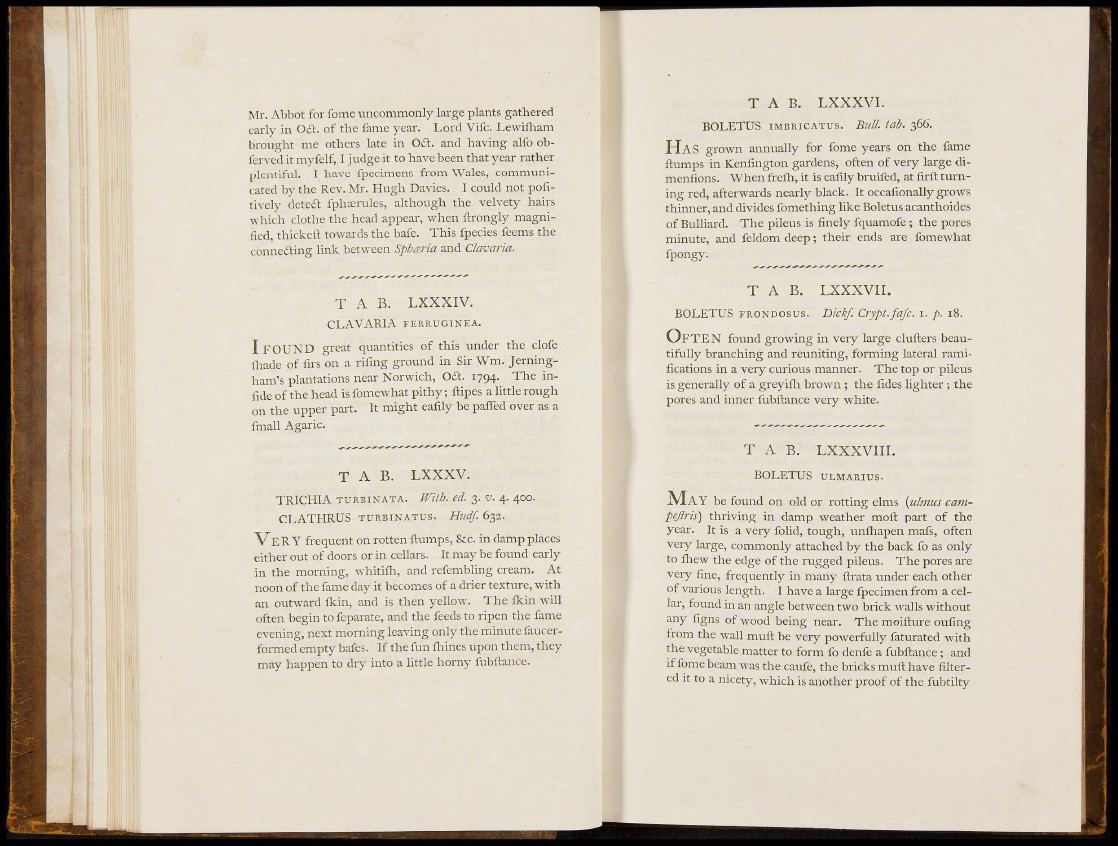
Mr. Abbot for feme uncommonly large plants gathered
early in o a . of the fame year. Lord Vifc. Lewifham
brought me others late in Oft. and having alfo obferved
it myfelf, I judge it to have been that year rather
plentiful. I have fpecimens from Wales, communicated
by the Rev. Mr. Hugh Davies. I could not pofitively
detea fphxrules, although the velvety hairs
which clothe the head appear, when ftrongly magnified,
thickeft towards the bafe. This fpecies feems the
connefting link between Spharia and Clavaria.
T A B . LXXXIV.
C L A V A R I A FERRUGINEA.
I FOUND great quantities of this itnder the clofe
iliade of firs on a rifing ground in Sir Wm. Jerningham's
plantations near Norwich, Oft. 1794. The infide
of the head is fomewhat pithy ; fl:ipes a little rough
on the upper part. It might eafily be paiTed over as a
fmall Agaric.
T A B . LXXXV.
TRICHIA TURBINATA. With. ed. 3. v. 4. 400.
C L A T H R U S TURBiNATUs. Hud/.e^^.
V e r y frequent on rotten flumps, &c. in damp places
either out of doors or in cellars. It may be found early
in the morning, whitilh, and refembling cream. At
noon of the fame day it becomes of a drier texture, with
an outward ikin, and is then yellow. The ikin will
often begin to feparate, and the feeds to ripen the fame
evening, next morning leaving only the minute faucerformed
empty bafes. If the fun flrines upon them, they
may happen to dry into a little horny fubftance.
T A B . LXXXVI.
BOLETUS IMBRICATUS. Bull. tab. 366.
H A S grown annually for fome years on the fame
flumps in Kenfington gardens, often of very large dimenfions.
When freih, it is eafily bruifed, at firft turning
red, afterwards nearly black. It occafionally grows
thinner, and divides fomething like Boletus acanthoides
of Bulliard. The pileus is finely fquamofe ; the pores
minute, and feldom deep ; their ends are fomewhat
fpongy. ^
T A B. LXXXVII.
BOLETUS FRONDOSUS. Bickf. Crypt.fafc. i. p. 18.
O F T E N found growing in very large cluflers beautifully
branching and reuniting, forming lateral ramifications
in a very curious manner. The top or pileus
is generally of a greyifli brown ; the fides lighter ; the
pores and inner fubflance very white.
T A B. LXXXVIII,
B O L E T U S ULMARIUS.
M A Y be found on old or rotting elms [ulmus campejlris)
thriving in damp weather mofl part of the
year. It is a very folid, tough, unfliapen mafs, often
very large, commonly attached by the back fo as only
to fliew the edge of the rugged pileus. The pores are
very fine, frequently in many ftrata under each other
of various length. 1 have a large fpecimen from a cellar,
found in an angle between two brick walls without
any figns of wood being near. The moifture oufing
from the wall mufl be very powerfully faturated with
the vegetable matter to form fo denfe a fubflance; and
if fome beam was the caufe, the bricks mufl have filtered
it to a nicety, which is another proof of the fubtilty